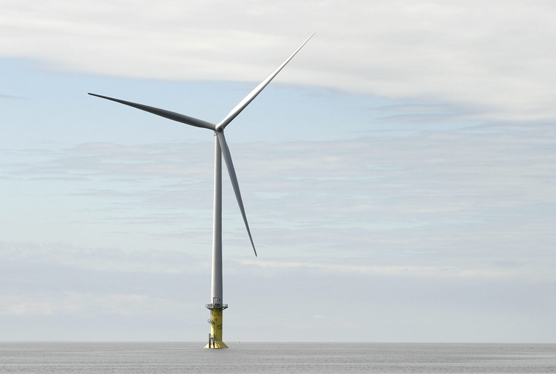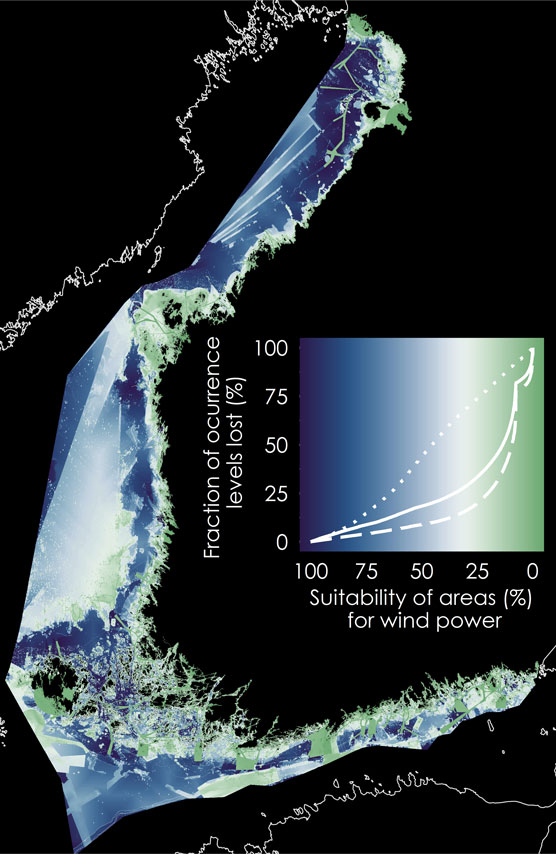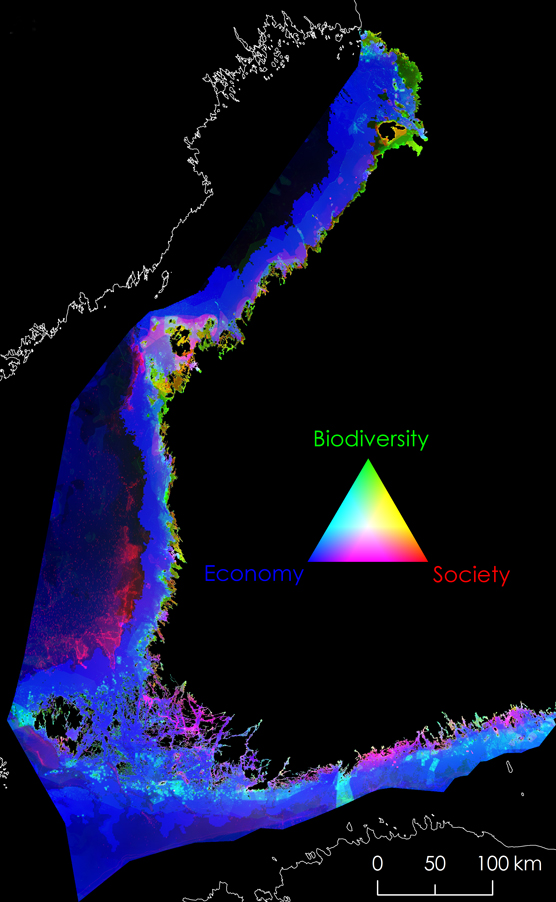Press release 2022-01-21 at 8:30

© Finnish Wind Power Association
Areas suitable for offshore wind power have been mapped in a new study. In the best areas, the production of wind energy is profitable, but the disadvantages for both people and marine nature remain small. Suitable areas were found in all marine areas.
Finland is committed to being carbon neutral by 2035. This objective requires the addition of sustainable forms of energy, including wind power. Setting up large wind power parks on land is a challenge, so businesses are currently looking out to sea. Finland is also committed to safeguarding biodiversity and offshore wind farms may contradict this goal.
Areas best suited for offshore wind power have been identified in an extensive study involving researchers from six Finnish organisations. The study identified marine areas where wind power can be built profitably and without major harm to other industries, humans, or marine nature.
The study balanced between the profitability of offshore energy and high environmental and societal impacts
Siting of offshore wind power requires assessment of both economic profitability and other consequences. The production of offshore wind energy is advocated by good wind conditions, and less disturbance to people. On the other hand, construction of large-scale offshore wind farms is hindered by high construction costs, and harsh weather conditions. Uncertainty has also been caused by the slowness of licensing processes for wind power construction, in part due to the need to assess the consequences of operations for marine nature.
In the newly published study, the profitability of offshore wind power was assessed over the entire life cycle of the wind farm: from construction to production and eventually to decommissioning. Impacts on people were assessed by determining to how many houses a wind farm could be seen, as well as identifying areas where harm to other livelihoods, such as fishing or fish farming, would be minimal. Among other things, the low landscape value close to industrial areas was determined as enabling factor.
The consequences of the construction of wind power for marine nature were assessed based on data collected by the Finnish Inventory Programme for Underwater Marine Diversity (VELMU). The data cover algae, vascular plants, and invertebrates, as well as rare and ecologically important species and habitats. In addition, the study took into account the fish reproduction areas, bird migration routes and, for example, nesting areas for white-tailed sea eagles.
Suitable areas in all Finland´s marine areas
The results of this study are presented on illustrative maps showing the areas best suited for wind power (Figure 1). The study also identified areas where construction of offshore wind farms would likely cause conflicts (Figure 2).
“It is possible to place wind farms in all Finnish marine areas in a cost-effective way, without significant harm to coastal residents and livelihoods, even so that the effects on marine nature remain minimal,” says Elina Virtanen, Senior Research Scientist at the Finnish Environment Institute, and lead author of the study.
The largest areas suitable for wind power generation can be found in the Gulf of Bothnia and Bothnian Bay. “Suitable areas are generally medium-deep and far from housing and sites with high natural values,” Virtanen says.
Smaller areas suitable for wind power also exist in the Gulf of Finland. “It would be sensible to place the production of renewable energy close to the consumers, for example close to the metropolitan area. However, due to reasons related to national defense the construction of wind farms in the Finland´s southern marine areas is not encouraged,” Virtanen says.

Figure 1. Marine areas suitable for wind power. On the map the best suited areas are colored in dark blue and least suited in green. The analysis takes into account the profitability of the construction and production of wind power as well as the effects on coastal residents and livelihoods, diversity of underwater marine nature and other natural values.

Figure 2. The study also identified areas where wind power is not worth planning due to likely conflicts caused by construction. In light blue areas, the most conflicts arise between wind power construction and nature, in pink areas between the construction of wind power and people. Areas where human and marine nature's interests are in conflict are yellow.
The world's best underwater nature data and land use planning software were used for wind power placement
The entire balancing operation was done using the Zonation software, designed for ecologically based land use planning. The same tool has been used in the past, for example, in expanding protected areas and locating ecologically valuable marine areas.
“What is innovative in this study on wind power is the simultaneous consideration of nature, society and economy. The materials used in the work are of high resolution, versatile and good quality. With the approach we were able to estimate the regional distribution of costs, and balance the benefits between offshore wind power, people, and marine nature,” says Atte Moilanen, Research Director at the Finnish Museum of Natural History at the University of Helsinki and the developer of Zonation.
According to VELMU coordinator Markku Viitasalo, the underwater nature data used in the study are among the best in the world. “VELMU data are also very multifunctional. In the past, they have been used to examine the adequacy of protected areas in the marine areas of Finland and to evaluate ecologically valuable marine areas that were included in Finland's first Maritime Spatial Plan,” says Markku Viitasalo, Research Professor at the Finnish Environment Institute.
Results interest wind power companies and land-use planners
The results of the study are useful for placing new offshore wind farms in a sustainable way. Each wind power project requires its own environmental impact assessment, but maps produced in the study can guide projects to where construction is still possible and the expected impacts on people and marine nature minimal. This is also useful for permitting processes.
Wind power companies and land-use planners have been very interested in the results. “There have already been a lot of inquiries, but we have been waiting for the publication of the study,” says Elina Virtanen.
The research was funded by the SmartSea project of the Strategic Research Council of the Academy of Finland, the VELMU program and MetZo III Project funded by the Ministry of Environment, and Kone Foundation. The study was a collaboration of several institutions. The authors of the research article comprise a total of 10 researchers from the Finnish Environment Institute, University of Helsinki, VTT Technical Research Centre of Finland Ltd., Finnish Meteorological Institute, Natural Resources Institute and Parks and Wildlife Finland.
The research article “Balancing profitability of energy production, societal impacts and biodiversity in offshore wind farm design” was published in the Renewable and Sustainable Energy Reviews series on the 16th of January 2022.
Inquiries:
-
Elina Virtanen, Senior Research Scientist (lead author of the study), Finnish Environment Institute, e-mail: firstname.a.lastname@syke.fi, tel. +358 295 251 055
-
Atte Moilanen, Research Director (developer of the Zonation software), Finnish Museum of Natural History, University of Helsinki, e-mail: firstname.lastname@helsinki.fi, tel. +358 50 338 8550
-
Markku Viitasalo, Research Professor (coordinator of the VELMU programme and the SmartSea project), Finnish Environment Institute, e-mail: firstname.lastname@syke.fi, tel. +358 295 251 742
-
Eija Järvinen, Communications Specialist, Finnish Environment Institute, tel. +358 295 251 242, firstname.lastname@syke.fi
Link to the research article:
Virtanen, E.A., Lappalainen, J., Nurmi, M., Viitasalo, M., Tikanmäki, M., Heinonen, J., Atlaskin, E., Kallasvuo, M., Tikkanen, H., and Moilanen A.: Balancing profitability of energy production, societal impacts and biodiversity in offshore wind farm design, Renewable and Sustainable Energy Reviews.
Full size maps: